





CANADA POST PUBLICATIONS MAIL PUBLICATIONS AGREEMENT No. 40027105 Postmaster: Please return undeliverable copies to The OGSA, Guelph Turfgrass Institute, G.M. Frost Building, University of Guelph, 364 College Ave E. Unit 3 Guelph ON, N1G 3B9 June 2024 Golf Course Renovations Cutten Fields OM246 CAN/AM Highlights Training Culture Investing in Your Team








MITIGATEMZ™




• on t ons gh Per ormance Tur to thstan E treme Plant tress
• utt ng E ge ormulat on that nclu es Tem lar Technolog




• Enhances Drought Tolerance & Promotes Root Growth




INFINITE™
• ons stent o l rat on



• ower Rate onger Res ual
• anages Plant tress & Drought Res onse










ELEVATE YOUR TURF MANAGEMENT GAME TODAY Powered by
target-specialty.ca turffuel.com TargetSpecialty TargetSpecProd Target Specialty Products targetspecialtyproducts
info@target-specialty.com

INSIDE THIS ISSUE

FEATURES
GC Highlight & Member Profile
Amanda Frend, Assistant Superintendent, Ladies’ GC of Toronto
Golf Course Renovations
The Pursuit of Cutten Fields Future - Preserving Our Past OM246
Training Culture
Qs for Training Program Planning & Execution
Investing in Your Team
REGULAR CONTRIBUTORS
Looking Back
50 Years Ago, Today
Ontario GSA Observes 50th Turf or Consequences
DEPARTMENTS
President’s Message
Editorial Committee
What’s New CAN/AM Highlights
INDEX OF ADVERTISERS
ALMACK AGRONOMIC SERVICES INC. 7 www.kooyagronomy.com
AQUATIC AERATION SOLUTIONS 21 www.aquatic-aeration-solutions.com 25
www.can.aquatrols.com
BANNERMAN 8, 23 www.sportsturfmagic.com 4
www.belchimturf.ca
BRAEMAR BUILDING SYSTEMS 6 www.braemarbuildings.com
BRETTYOUNG 19 www.brettyoung.ca/turf
ON THE COVER
GREENHORIZONS 31 www.greenhorizonssod.com/golfcourses
JOHN DEERE 26 www.deere.ca/en/golf
ONTARIO SEED COMPANY 14 www.oscturf.com
P.D. SOLUTIONS 10 www.pdsolutions.ca
TARGET SPECIALTY PRODUCTS 2 www.target-specialty.com
TURF CARE 13, 32 www.turfcare.ca
ZANDER SOD CO. LIMITED 23 www.zandersod.com
The clubhouse at Essex Golf & Country Club, host golf course for the 2024 CAN/AM Challenge in Windsor, ON. Photo taken by Courtney White.


Editor Madeleine White projects@ogsa.ca
Publisher Diane Davey diane@blenheim.ca
Advertising & Administrative Manager
Diane Davey diane@blenheim.ca Tel: 289-337-4305
Production & Design
Patrick Kilborn patrick@blenheim.ca
ONCourse is published four times a year (November / April / June / August) by Blenheim INK for:
Ontario Golf Superintendents’ Association
Tel: 519-767-3341 Toll Free: 877-824-6472 Email: admin@ogsa.ca www.ogsa.ca
Published by Blenheim INK Administration Office: 503-5340 Lakeshore Road Burlington, ON L7L 7A8 www.blenheim.ca
ONCOURSE 2024
Although every effort is made to check material for publication, the association is not responsible for material published on behalf of its contributors. All rights are reserved by the publisher and any reproduction in whole or part without the written permission of the publisher is prohibited. Although some trade names may be mentioned in articles contained in this publication, no endorsement is intended or implied by the Ontario Golf Superintendents’ Association.
OGSA is committed to serving its members, advancing their profession, and enriching the quality of golf and its environment.
JUNE 2024 | ONCourse 3





Penthion SC



Turf Fungicide



SDHI Technology with Broad Spectrum Control


Unlock the Potential of Penthion SC
Penthion SC turf fungicide is a distinctive SDHI that controls Anthracnose, Dollar spot, Brown patch, Summer patch and more. Penthion SC’s new, suspension concentrate formulation offers odorless, convenient, and effective control of multiple key summer diseases to protect your high value turf throughout the growing season.



Always Read and Follow Label Directions. Penthion is a trademark of Belchim Crop Protection Canada Inc www.belchimturf.ca
Penthion

Building a Diverse and Inclusive Industry
The 2024 season is well underway and has been a relatively decent start as far as weather is concerned. The warm winter, with an above average March, rainy and cool April, and a mild May has made for a good start for the turf. Most of our focus through the late part of the winter is filling all vacancies in the department. I hope everyone had success hiring for these positions, and that you have a smooth
As we scan through the membership roster, we notice that there is a large percentage of members who will retire over the next decade. I mentioned in my last President’s Message that recruitment is top of mind for this board as the industry needs to attract a new generation of golf course turfgrass personnel. The OGSA board met March to discuss critical projects and future strategies over the next few years. This includes connecting with youth in our communities through the First Green program, and allocating part of our annual budget to create recruitment tools for the association and members to use at job fairs and at high school career fairs.
This year, we are taking a new approach to the compensation and benefit survey to gather valuable information for our members. It has been several years since the OGSA has completed one, and our goal is to give superintendents the tools and resources they need to successfully advocate for their budgets and employees and help elevate our standing in the industry. You will receive an email from the OGSA shortly to take part, and I encourage you all to do so. We are working with Ernie Coetzee, employment lawyer
and one of our 2024 conference speakers, to build a win-win employment contract template for OGSA members to use as a guide during contract negotiations.
We want to start providing insight into the upcoming workforce and help develop robust recruitment and retention skills in our membership. Building a diverse and inclusive industry that will funnel into a larger stream of people to fill the in-
We encourage you to reach out to the association to let us know what programs or services you would like to see us provide members. We are here to serve you.

job description is written. The words we choose when writing job descriptions and listing qualifications are important when trying to reach a larger pool of individuals. (Conversely, men are more likely to apply for a position if they feel they meet 40% of the qualifications listed on a job description.)
A second key takeaway for me, was that 44% of new hires regret their decision to join an organization within a week. Making a good first impression and having a strong onboarding plan will start the new employee off on the proper journey and using inclusive language and behaviors will go a long way to creating a sense of belonging for all employees within the organization. These are all topics that we will tackle to help develop our leadership skills.
demand positions, begins with a strong leader and a great in-house recruitment process.
This past winter I had the opportunity to be a part of a two-day Inclusive People Practices seminar which focused on equity, diversity, and inclusion. Did you know that statistically a woman will only apply for a job if she feels that she has 90% of the qualifications? It’s staggering to think how many qualified people might not apply for a position in this field because of how a
We intend to bring these topics to life at the next conference, but in the meantime, ONCourse is an excellent way for us to provide you with articles on leadership. In the April issue, we published a summary of Chris Tritabaugh’s session on “10 Rules For Leadership and Balance” and in this issue you can check out an article on “Investing In Your Team.”
As always, we encourage you to reach out to the association to let us know what programs or services you would like to see us provide members. We are here to serve you.
Keep an eye on your inbox for emails for upcoming event registrations over the next few weeks. I hope everyone has a great summer. ■
JUNE 2024 | ONCourse 5
MESSAGE
Ian McQueen, OGSA President, Superintendent at St. George’s Golf & Country Club.
Thank you, ONCourse Committee!! Without your time and efforts, we would not be able to pull off yet another great issue for our members. Enjoy, everyone!

Chris Lecour Writer & Content Development; Sr. Turf Sales Representative, BASF.


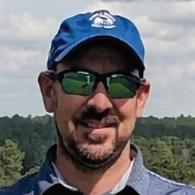


Andrew Marsan Writer & Content Development; Turf Technical Sales, Plant Products.


Mark Wiebe Writer & Content Development; Assistant Superintendent, Oakdale GC.

Al Schwemler Associate Editor, Writer, & Content Development; Fisherman Extraordinaire; Past President OGSA.

Joel Johnston Writer & Content Development; Superintendent, West Haven G&CC.
Braemar Building Systems





6 EDITORIAL COMMITTEE
Madeleine White Editor, Writer; Member Services & Marketing Advisor, OGSA.
Marco China Writer & Content Development; Superintendent, Deer Ridge GC.
Kevin Collier Writer & Content Development; Superintendent, RiverBend GC; Director, OGSA.
Lisa Marie Guilfoyle Writer & Content Development; Assistant Superintendent, Oakville G&CC.
BuildingSystems BRAEMAR
• Maintenance Buildings • Storage Facilities • Pump House • Half Way House • Washrooms For your FREE ESTIMATES call us at 1-800-215-1996 www.braemarbuildings.com
WHAT’S NEW
 By Courtney White, Executive Manager OGSA. manager@ogsa.ca
By Courtney White, Executive Manager OGSA. manager@ogsa.ca
FIRST GREEN
The First Green initiative is gaining traction in Ontario! Ken Tilt, superintendent at The Club at North Halton will host a First Green on June 12th and Kevin Collier will host a First Green on August 1, 2024. We encourage you to consider participating in this incredible program that connects youth to turfgrass science. It’s critical that we all work together to expose young people to our industry as we look to the future of golf. There are a limited number of $500 grants available to GCSAA members to use for transportation costs and/or supplies you may need to host your First Green field trip. OGSA members, if you are interested and require funding, please contact the OGSA office to see if we can provide support.
If you have any questions, or are interested in participating, contact Ryan Scott, Superintendent at Oakville GC and OGSA Past President for more information –RScott@oakvillegolfclub.com.
SCHOLARSHIP WINNERS
TODAY IN ONTARIO!
The season is well underway, and we want to see those photos! Tag @OntarioGSA, and #TodayInOntario to enter the contest! Not only will you have a chance to win some $$, but your photo could also be featured in our 2025 calendar!
2025 OGSA TURFGRASS MANAGEMENT CONFERENCE JOINS WITH THE CANADIAN
For those of you who missed the announcement at the conference in January, we are pleased to announce that the OGSA and the CGSA will partner to host a joint conference in February 2025, in Niagara Falls, Ontario! We are already starting to plan The Canadian and what promises to be a leading conference and tradeshow event in Canada.
We can’t wait to see you all there.

Three cheers for these up-and-coming turfgrass managers! Best of luck to you all throughout the season as you start your careers! Please be sure to check out the scholarship opportunities for OGSA members at ogsa.ca.
Paul Brown Internship, Funded by G.C. Duke
Congratulations Zach Weber!
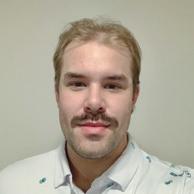

OGSA Turfgrass Education Awards
Congratulations Owen Singer and Nicholas Lafontaine!


Turf Managers’ Short Course Award
Congratulations James Corry and Cody Fair!


JUNE 2024 | ONCourse 7
Zach Weber Owen Singer Nicholas Lafontaine
James Corry Cody Fair

HISTORICAL THROW BACKS
In celebration of the OGSA’s Centennial Year, we have been sharing throwback articles that cover the history of our association, relevant fun facts about our industry, oldschool tips and tricks of the trade, and stories written by the membership. If you have any similar content you’d like to see published, please submit it to admin@ogsa.ca!
HISTORICAL PHOTO REEL
We have had a lot of requests to post the photo reel that we played at the OGSA Turfgrass Management Conference. Friends, the file is HUGE, and we can’t post it on the website. If you are interested in getting a copy of the reel, please reach out to us directly and we will package it up and send it your way!
CHLOROTHALONIL USE UPDATE
Further to the Pest Management Regulatory Agency’s re-evaluation decision dated May 10, 2018, chlorothalonil use for turf is restricted to two (total) applications per year at labelled rates for control of foliar diseases plus one application in the fall for snow mould control.
PMRA have clarified the meaning of “two applications” using the following examples for clarification:
If an application using a product containing chlorothalonil is made to greens one week and an application is made to the fairways the following week, then no more applications would be allowed that season other than one application for snow mould.
Another example would be, if a golf course makes an application of a product containing
chlorothalonil on greens, tees, and fairways on July 1 and then it is applied 14 days later on the same areas, then no more applications would be allowed that season other than one application for snow mould.

For further information, you can contact the PMRA directly at pmra.info-arla@hc-sc. gc.ca
As of March 2024, AET Group is providing clarification on chlorothalonil use to those who reported the use of chlorothalonil in their 2023 Desk Reviews if more than two applications, (excluding one application or snow mould) are made. ■

August 12, 2024 OGSA Assistants’ Tournament
September 23 & 24
OGSA Championship Muskoka Bay Resort & Taboo Muskoka


8
WHAT’S NEW Alexandra Bond CLASS C The Ridge at Manitou GC Ryan Chauvin CLASS B Rochester Place GC & Resort Alex Laskin CLASS C Sunningdale G&CC Matthew Potter CLASS B Deer Creek Spencer Weber CLASS A Deer Creek John Gabel CLASS C Glencairn GC WELCOME to Our New Members Multi-Ject Aerator Bannerman BA-400-S/S-H 1. Eliminate surface disturbance and core residue 2. Clean cut entry and exit of time 3. Aerify & putt immediately after 4. Revitalizes and encourages roots to growth Call Bannerman today: 1-800-325-4871 Clean Green
MARK YOUR CALENDARS UPCOMING OGSA EVENTS
St. Thomas
G&CC

2024 CAN/AM Challenge
CANADA KEEPS THE CUP
Everyone felt like a winner having the chance to play at beautiful, balmy Essex G&CC at the end of April. The weather was almost tropical and what a treat to see so much green after a long grey winter! As Teams USA and Teams Canada rolled in for registration, there was no doubt that MiGCSA and OGSA players were in for a great day of friendly golf competition, camaraderie, and food and drink. The team at Essex knocked it out of the park with their hospitality, attention to detail, and delicious meals.
Players started their day with a shotgun start at 10am and thanks to Aquatrols and Allturf, they were treated to an afternoon Mac N’ Cheese snack, and a Caesar.
As we celebrate the OGSA’s 100th year as an association, we are enthusiastically taking advantage of each opportunity to dig a little deeper into our association’s history. One question that keeps coming up is this: how many years has the CAN/AM been around? According to the trophy, the CAN/AM as we know it today, was born in 1993. However, we think superintendents from Ontario and Michigan have been coming together since well before that. An article found in a 1991 issue of Green is Beautiful, states that on April 29th, 1991, 132 golfers tee’d it up at the Grosse Ile G&CC in Detroit. There were 37 Canadians and 95 Americans, and “The YANKS beat the Canadians for the first time in many years for the team prize.” Which puts the beginning of the U.S./Canadian team competition somewhere in the 80s. We

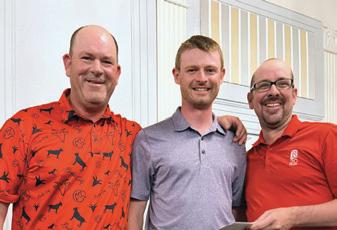
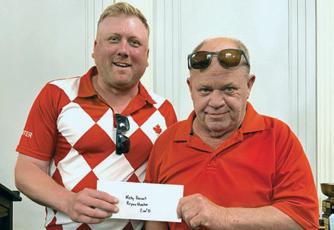

also know that Ontario superintendents were invited to the Border Cities Meetings and tournaments as early as 1981.
Although there are some gaps in the history of our groups coming together, we think that we have been coming together to share ideas and engage in friendly competition for 43 years minus the two years that boarders were closed, or difficult to cross due to the pandemic.
The CAN/AM Challenge continues to attract a significant number of superintendents on both sides of the Michigan – Ontario Border. On behalf of Canada and the OGSA, we owe our thanks to seven-time host superintendent, and OGSA past president, Chris Andrejicka, for being such a supporter of this tournament. Chris was presented with a plaque acknowledging his 15 years of continuous support.
JUNE 2024 | ONCourse 9
NEW
WHAT’S
1st Place Low Gross (L-R): Trevor Hunter, OSC & Ben Wheeler, Redtail GC with OGSA VP Kevin Collier, RiverBend GC.
1st Place Low Net: Bryan Hunter, Seven Lakes Championship G&E & Kelly Barnet, BrettYoung.
2nd Place Low Net (L-R): Dave Jacobsen, Weston G&CC & Chris Nelson, Target Specialty, with OGSA VP Kevin Collier, RiverBend GC.
2nd Place Low Gross (L-R): Tim Hornick, GolfNorth & Kyle Payne, Essex G&CC with OGSA VP Kevin Collier, RiverBend GC.



Superintendent, and MiGSA member, Ryan Moore from Forest Lake CC was also in attendance and plays an equally critical part in ensuring the tradition of the CAN/AM Challenge continues on the Michigan side of the boarder. As a nod to his Canadian roots and his dedication to superintendents on both sides of the boarder, the OGSA presented Ryan with an ongoing complimentary membership to the OGSA and a 100-year OGSA pin.
Joe, It's Getting Close to Cutty Time.
to the Pin #12: Kevin Frank, Michigan State University.
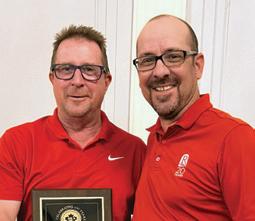
2024 CAN/AM 15-time host superintendent Chris Andrejicka (L), Essex G&CC receives recognition plaque from OGSA VP Kevin Collier (R), RiverBend GC.

OGSA VP Kevin Collier (L), RiverBend GC & 2024 CAN/ AM Host Superintendent Chris Andrejicka (M), Essex G&CC, present Ryan Moore (R), Superintendent & MiGCSA member from Forest Lake CC with an ongoing, complimentary membership to the OGSA.
The nostalgia continued as Kevin Frank from Michigan State Univeristy, took the stage to say a few words about Dr. Joseph Vargas, professor of Plant Pathology/ Turf Grass Management at Michigan State University, who recently passed away. Shots of Cutty Sark were passed around and Kevin shared, “We’d always tell Joe, it’s getting close to Cutty time, and as soon as you told him it’s getting close to Cutty time, it was like he could see the finish line, and all the sudden the strokes started coming and the putts started falling, so this one’s to Joe, Rest in Peace.” ■
Essex G&CC
Kelly Barnet, BrettYoung & Bryan Hunter, Seven Lakes Championship G&E
Dave Jacobsen, Weston G&CC & Chris Nelson, Target Specialty
Closest to The Pin #5: Ryan Moore, Forest Lake CC
Closest to The Pin #12: Kevin Frank, Michigan State University
U.S.A – 28
1st Place Low Gross:
73: Chester Vandenberg, Corteva Agriscience & Kevin Doyle, GCSAA
2nd Place Low Gross:
73: Brian Schweihofer & Matt Prince, Franklin Hills CC
1st Place
57: Sean Maas, Lake Shore Sand Co. & Mark Prieur, James Dick Construction
2nd Place
62: Steven Forrest, Hills ForrestSmith (GC Architects) & Kevin Frank, Michigan State University
Longest Drive #13: Ben Wheeler, Redtail GC
Longest Drive #6: Jerry Richard, Craigowan G&CC


10
Get your recertification credits ON-LINE with Now offering P.D. Solutions Visit: www.pdsolutions.ca or call 1-877-977-6774 IPM Certified ATTENTION! Agents MORE Courses! ★ ★ THE WINNERS CIRCLE CANADA – 41 1st Place Low Gross: 70: Trevor Hunter, OSC
Ben Wheeler, Redtail GC 2nd Place Low Gross: 74:
1st Place Low Net: 58:
2nd Place Low Net: 60:
&
Tim Hornick, GolfNorth, & Kyle Payne,
Low Net:
Low Net:
Closest to the Pin #5: Ryan Moore, Forest Lake CC.
Longest Drive #13: Ben Wheeler, Redtail GC.
Closest
View All CAN/AM Photos
LADIES’

(905) 889-3531
ladiesgolfclub.com
ABOUT THE COURSE
In their centennial year, Ladies’ Golf Club of Toronto is still North America’s only private golf club created by women for women. The club was founded in 1924 by Ada Mackenzie. In 1925, 9 holes were open for play. On August 23, 1925, the official opening event was played. This was a match between Ada Mackenzie and Helen Paget of Royal Ottawa Club. A premier championship par-72 course (par-70 for men) that has long, narrow fairways; small greens; and lots of enticing challenges as it winds along the East Don River. Members have priority access to tee times and can play unlimited rounds of golf. Men are welcome as Guest Card Holders and guests.
Architect: Stanley Thompson
Type of Club: Private
Number of holes: 20 (the 9th hole is located at the furthest east point of the course. Therefore, members and guests alike, that wish to only play 9, break off at the 7th hole and play 8 alternate and 9 alternate, thus bringing them back towards the Golf Shop, Clubhouse and parking facilities).
Number of rounds annually: 28,000+
Practice Facility: Yes - Driving range, short game facility and hitting nets.
Number of staff year-round/seasonal: 25
Member since 2014
Amanda Frend
Assistant Golf Course Superintendent, Ladies’ Golf Club of Toronto.


 Written by Lisa Marie Guilfoyle, Assistant Superintendent, Oakville Golf Club. Photos provided by Amanda Frend.
Written by Lisa Marie Guilfoyle, Assistant Superintendent, Oakville Golf Club. Photos provided by Amanda Frend.
Perseverance, the one thing that stands out in Amanda’s mind that has helped her get to the peaceful position she is in today. “Remember, you’re not supposed to have it all figured out kid, that’s the journey.” A quote from her best mate, Nikki, that has stuck with Amanda for years throughout the expeditions of life. A motivating mantra that keeps her persistent yet grounded.
Amanda’s story does not start in the classroom. As she likes to say, she attended the “school
of hands on!” and twenty plus educational conferences in the last 15 years. After putting in many years landscaping and working at her family’s stone masonry businesseven dabbling with the idea of becoming a Police Officer - in 2009, Amanda applied at the Ladies’ GC of Toronto. As a seasonal greenkeeper, she quickly fell in love with working hard to produce a product and seeing the results within the industry. With her ‘give it your all’ attitude, it was immediately clear to her management team that she is an asset to the club, which allowed her to expand into an exceptionally professional and knowledgeable grass grower and active mentor for women in golf. She officially took the title of Assistant
JUNE 2024 | ONCourse 11 GC HIGHLIGHT | MEMBER PROFILE
Thornhill,
GOLF CLUB OF TORONTO 7859 Yonge Street,
ON L3T 2C4
The historic clubhouse at the Ladies’ Golf Club.
Amanda Frend, Assistant Superintendent, Ladies’ Golf Club of Toronto.
Q: Favourite golf tournament?
A: CPCK Canadian Women’s Open.
Q: Favourite piece of turf equipment?
A: Skid Steer, ok ok, Toro 648.
Q: Favourite golf course?
A: Manitoulin Golf and Country Club.
Golf Course Superintendent in April 2014. Her work ethic and passion to expand has paved the road to have a successful career in golf course management. “I have been asked several times when I will try to make the transition to Superintendent. I don’t know if that is what I want or need. I currently love where I am. I love to be boots on the ground every minute of every day. My current role allows me to do that,” Amanda expresses. “I am very fortunate to work under a great superintendent, John McLinden. From the beginning, he never hesitated to take me under his wing, signing me up to be a member of our associations and sending me to conferences. Thus, providing me with education, information, and networking - all at my fingertips. Previous assistant superintendents John Ingam and Rino Pandolfi, also did the same.”
Throughout the years, Amanda has been involved in many projects at the Ladies’ GC such as a complete par 3 renovation, reshaping
WHAT YOU NEED TO KNOW
Predominate grass type: Bent/Poa mix on greens, tees, fairways
Predominant soil type: loamy soil/clay soil
Types of greens: 16 Push -up, 4 California style
Course Length: 6000 yards
Size of Property: 123 acres
Size of Greens: 2.2 acres
Size of Tees: 2.2 acres
Size of Fairways: 24 acres
Major Challenges: Mother Nature
Q: Ultimate foursome?
A: Brooke Henderson, Mel Reid, and friends!
Q: Lowest round and where?
A: Couldn’t tell ya, but I bet the beer was good.
Q: Favourite Meal?
A: Chicken and eggs are my two favourite foods.
Q: Favourite Movie?
A: Rudy
Q: Favourite Season?
A: Fall
Q: Favourite Band?
A: That varies immensely depending on activity or mood. Pitbull to Pink to Chris Stapleton to AC/DC.

of their target greens as well as constructing a raised veggie garden with an interlock patio used for small weddings and gatherings. This project is something to be admired as the vegetables grown in these new gardens are used in the culinary production in the club’s kitchen. Now, in their centennial year, the clubhouse is undergoing a full renovation. With the existing structure being historic, it will not be torn down, keeping the exterior true to its original appearance. Its farmhouse style is no longer appropriate for its modest use. At this stage, the interior has been completely gutted with some walls being knocked down for an open concept to accommodate larger functions. The addition that was built in the 1980’s has been torn down and a new addition will house a brand-new kitchen. There is also a three seasons room being added for versatility. John, Amanda, and their team have been very busy this spring assisting in providing the locations for a temporary building and parking for their members and guests.
As a manager, Amanda strives to lead by example by showcasing her determination as well as being personable. She describes her management skills simply as just showing them both sides of herself - that she is not only a work horse but human too. Amanda believes this approach has given her the opportunity to get to know her staff well and build the relationships that provide her with the desired outcome of productivity. For those of you that know her, this does not come as a surprise. Amanda is friendly, kind, and generous by nature.
Amanda and her partner Mandi of 11 years, purchased their first home a few years ago, bringing even more pride into Amanda’s life as she has referred to it as one of her biggest accomplishments. They and their two teenage daughters (Charlotte, 17 and Mikayla, 14) love spending time together, along with their dog and two cats. When Amanda is not at the work perfecting the course, you can find her at home puttering about doing the same.
12
The (Ontario division) Women in Turfgrass Management Mentor Programs’ yearly tournament was held at Ladies’ Golf Club of Toronto in 2022.
IN THE HOT SEAT
She loves small woodworking projects and recently completed a bathroom build in her basement. Amanda is always keeping her hands busy and teaching her daughters how crucial it is to work hard to achieve the things you want. While away from both work and home, you can find the family cottaging in Spring Bay on Manitoulin Island during the summer months. “I often play 4 or 5 rounds at Manitoulin Golf and Country Club. A must is hitting up Split Rail Brewery in Gore Bay,” Amanda shares. “And I love to travel to the Caribbean in the winter months.”
Did you know that women make up only 1% of leadership roles in the golf and turf industry? As a woman also included in this staggering percentage, I am beyond grateful to know Amanda and call her not only a colleague but a friend. We are two of the fifty women that were sent to North Carolina in 2019 when Bayer (now Envu) expanded the Women in Golf initiative. She and I are also mentors for the Women in Turfgrass Management Mentor Program (shout out to the founder Morgan Creighton of Woodside Golf Course in Airdrie, Alberta) that reaches young inspiring female students in turfgrass programs across Canada. Amanda has continued to be a strong presence in this
important community and most recently was invited to Shaughnessy Golf and Country Club in Vancouver for the CPKC Women’s Open in 2023. Alongside her as mentors were Miranda Robinson and Patricia Sloan from British Columbia, and Lesley Thomas, a fellow Ontarian, with students Mackenzie Levesque and Michelle Smith from British Columbia, and Shannon Perry and Hannah Isinghood, both from Alberta. The objective of this experience was to have the eight women assist the Shaughnessy Turf Crew with the daily responsibilities throughout the entirety of the tournament all while facilitating a broader range of education and
networking opportunities. A very successful and memorable event for all involved.
Amanda shares that many of her successes are possible due to the unwavering support she receives not only from her partner Mandi, but her best friend Nikki and loving Mother. “These are the people I look up to most!” This is very heartwarming to hear, and I hope she knows how much many of us look up to her and her ability to continue to persevere, providing high quality results all while opening doors for the next generation to walk in the same muddy boots. ■
“Amanda Frend is a kind, compassionate leader who likes to have her boots on the ground working with the crew. She is dedicated to furthering her knowledge and experiences at conferences and events with a smile on her face. She is the first person to check in to ask how you are doing which speaks to her character. The industry is a better place with people like Amanda representing it.”
– Miranda Robinson, Victoria Golf Club










JUNE 2024 | ONCourse 13
Spring Irrigation Deals are Back! BUY 4 GET 1 FREE! TORO Infinity & FLEX Series Sprinklers, Riserless Bodies or Conversion Assemblies 11-800-561-TURF (8873) x7502 | turfcare.ca Let us show you an easy and affordable path to the latest in irrigation technology. Inquire about our flexible financing solutions. @TurfCareProdCA @Gr8estShowOnTRF

THE PURSUIT OF CUTTEN FIELDS’ FUTURE
Preserving Our Past
Written by and photos provided by Bill Green, Golf Course & Grounds Superintendent, Cutten Fields.
Golf course renovations often stem from a desire for improvement that is initiated by a combination of a passionate membership, club management, and other key stakeholders. Behind every renovation is a unique story to be told; there have been few renovations that have come together as uniquely as that of Cutten Fields.
HISTORY
Cutten Fields was designed by amateur golfer Chick Evans, who was



the first golfer to win the US Open and US amateur in the same year. Canadian Architect Stanley Thompson also contributed to the original design; however, it is believed his involvement came later in the process. Since the club’s opening in 1931, the course had undergone numerous changes over the past 92 years including the sale of a portion of the back 9, the addition of mounding around green sites, and numerous bunker renovations to bring bunkers closer to shrinking greens. The original design along with many of the unique features had been lost or altered as time passed. It was time to look at reinvigorating the golf course while restoring some of the features that made Cutten Fields distinct from other great Canadian golf courses. The search began for an architect that could revitalize Cutten Fields.



Using our proprietary POLYGRAPH® software, your Harrell’s Golf Specialist can help you dial in just the right prescription for your turf’s POLYON® controlledrelease fertilizer needs
RELIABLE SPACE
POLYON® fertilizer’s durable prill preserves the nutrients within the substrate and ensures a proper rate of release, providing consistent greening all season long.



FERTILIZER YOU CAN COUNT ON. PREDICTABLE


DURABLE
POLYON® fertilizer’s original reactive layers coating process creates a durable, uniform adhesion between the polymer coating and the heated urea substrate.
SUSTAINABLE
POLYON® fertilizer offers a reduced environmental impact. With more efficient nutrient uptake, significantly less environmental loss and fewer applications required, you get more with less!

For more information about POLYON® Fertilizer and the POLYON® Guarantee, visit nutrite.com and oscturf.com
Nutrite Toll Free 1-800-265-8865
OSC Toll Free 1-800-465-5849
Contact your OSC or Nutrite Sales representative today!
Providing consistent, reliable predictable results for 30 years

THE ORIGINAL REACTIVE LAYERS COATING






14
CONTROLLED-RELEASE
5th green at Cutten Fields is being established behind the old green. Features of the new green include a 41% increase in size; you can see how we utilized the cart path to increase entrance and exit points in comparison to the old path on the left. The old path and green have since been removed. Photo taken by David Braun.
A cross-section of POLYON® 41-0-0 prill with polymer coating adhered to urea substrate 31-0-5

THE PROCESS
As part of the selection process of the architect, the Golf Course and Grounds Committee established and prioritized various club objectives. This process proved to be a valuable exercise to keep the design and methods in sync with our objectives because sometimes clubs can get lost in the process and excitement of it all. The following objectives were approved by the committee and were incorporated as part of the improvement plan:
1
Maintain the spirit of Chick Evans and Stanley Thompson. If, as set out in the club’s Guiding Principles, we are to be true to the spirit of Stanley Thompson, we should recognize that time has diminished the presence of the Thompson spirit. We now have an op portunity and perhaps a responsibility to “move the course forward by taking it back to its roots.”
2 Respond to technological advances of the modern game. These advances have resulted in the course losing some of its original design defenses, such as bunker positioning and fairway shapes and contours.
3 Attend to safety concerns. Address the safety concerns of golfers, staff, and neighbouring properties.
4 Advance agronomic conditioning and consistency. Limit and reduce risk of winter damage and summer stress by increasing green sizes, increase pinnable areas, improve surface and subsurface drainage, improve traffic flow on greens, and promote hearty turf varieties.
5 Financial benefits. Reduction of financial inputs should be considered when creating any new design features.
6 Environment benefits. A more natural course will be more environmentally friendly and will likely reduce the amount of water and chemical use.
7 Competitive positioning of Cutten Fields. The club’s value is determined through the myriad of intangibles –obviously the golf course is our key tangible asset. A comprehensive master plan must provide us an opportunity to significantly enhance the golf course and thereby differentiate the Cutten Fields golf experience in a competitive golf market.
After a lengthy selection process that included an RFP (request for proposal) process and multiple interviews, Jeff Mingay was appointed course architect in 2016. The Golf Course Improvement Plan was developed in 2018, however the club was still investigating the best solution to improve the greens and mitigate the constant threat of winter injury.
A DEEPER LOOK INTO ISSUES – GREEN SITE EVALUATIONS
Agronomically, the golf course was falling short on member expectations as the putting greens could not perform consistently with the constant threat of winter injury on predominately undersized Poa annua greens. A comprehensive green site evaluation was completed to help direct the club on how the greens could be improved. It quickly became evident that the club had too many deficiencies to simply add drainage or expand greens to solve the myriad of problems. The common deficiencies included inadequate sunlight, limited entry/exit points, poor surface drainage on the greens themselves and many of the green surrounds had mounding and slopes that were draining onto greens, absence of internal
drainage, inadequate square footage, and a lack of pin locations due to severe slopes.
Ultimately this process provided what we would use as the guiding principles to the development of new greens at Cutten Fields, as part of the Golf Course Improvement Plan. Looking ahead 30 years down the road, we wanted a future greens site evaluation to hit positively on as many categories that were in our control. If we could achieve that goal, the greens at Cutten Fields would be set up for many years of success. Additionally, if the club was to take on the financial burden and effort to build new greens, why fall short on any controllable factor like green sizes or entry/exit points.
JUNE 2024 | ONCourse 15
Jeff Mingay restored some symmetrical features at Cutten Fields including this rectangle green on the 18th hole. Jeff utilized the preliminary plan and old photos to replicate the original green shape.
The photo above was cropped from a preliminary plan. This certainly adds a layer of mystique and curiosity into how and when exactly Stanley Thompson became involved in the design process. The preliminary plan contains existing bunkers and proposed
THE GREEN-SITE GUIDING PRINCIPLES:
1. Sunlight: Maximize both morning and afternoon sunlight. This included tree removal and relocating greens where required.
2. Air Movement: Maximize air movement where possible by removing trees or underbrush.
3. Entrance and Exit points: Three or more entry and exit points per green.
4. Green Size: Minimum 6200 ft.²
5. Pinnable Area: 4200 ft² of pinnable area at 1.5% to 3.5% slope.
6. Surface Drainage: Multi-directional surface drainage off putting green surfaces.
7. Internal Drainage: 10-foot centres.
8. Purity of Stand: 007 Creeping Bentgrass.
Unfortunately, we could not successfully address all of these principles on every hole. In those circumstances, the architect simply compensated by increasing the green size and/or sloping the surface of the green to face south to maximize exposure to light
GOLF COURSE IMPROVEMENT PLAN - IMPLEMENTATION
In the spring of 2019, the club experienced yet another bad winter and this set the stage for the addition of 18 new greens to the Golf Course Improvement Plan. Preparation began for a member vote to take place in the fall of 2019. A communication plan was developed with long-time Cutten Fields member Joan McVean, who had a wealth of knowledge and experience in communications with the local school board. The club conducted focus groups to help determine the best way to approach the project with respect to disruption ONLY, and not soliciting them for input on the necessity of the improvement plan. We offered walking tours to members to observe and discuss historically troubled greens. For comparison, the tours also included viewing the new pure bentgrass greens at the Guelph Turfgrass Institute. The most successful walking tour was on Men’s Night, where we provided refreshments and a putting competition after a short presentation. Also, the club hosted multiple townhall meetings, which included presentations from Dave Oatis (Consulting Agronomist), Bill Green, and/or the charismatic Jeff Mingay. Communication and education were critical in achieving a 95% vote in favour of the Golf Course Improvement Plan.
The original Golf Course Improvement Plan was approved on the premise that Cutten Fields staff would complete 5 holes in-house. These were holes where we could build the new green behind or beside the current green so golfers could essentially keep playing with minor inconveniences. Initially, a contractor was scheduled to finish the remaining 13 holes, with the condition that we would utilize temporary greens and keep the course open for play as much as possible. When covid hit, there was so much uncertainty that the club decided to put a hold on the contractor portion of the project, but work continued on the other five holes. During this time, Pro Shop and clubhouse staff assisted with construction on the golf course.
Once covid restrictions subsided and things got rolling again, the club was ready to complete the final 13 greens, but major changes were on the horizon. Over the course of completing the first five greens, we had essentially trained a construction crew who could install drainage, irrigation, and build bunkers, tees, and cart paths. Confidence in executing this project completely in-house quickly grew within our management team, staff, and the membership; sure enough, the talented team at Cutten Fields, along with Jeff Mingay, executed this unimaginable task – in-house – all while keeping the course open and playable.
16
bunkers. Despite the unique architectural history, Cutten Fields will always be known as the “home of Stanley Thompson” as he once owned and managed the club.

THE IMMENSE SCOPE OF THE PROJECT INCLUDED
• Relocating two holes to address safety concerns
• Construction of 18 modified California putting greens
• Tee deck renovations that focused on improving separation between decks, more forward tees, and adding length where possible (Cutten Fields is now over 7000 yds)
• Construction of 67 new bunkers
• New cart path systems to improve entry and exit points
• All related irrigation works
This project could not be completed in-house without a very talented group of individuals. Mark Hughes, who had recently joined our team at Cutten Fields, had 18 years of experience as a project manager for a golf course construction company. Mark travelled throughout the US and Canada renovating and building golf courses. This was certainly a different situation for Mark, being on this side of a major project, as he was able to contribute in a meaningful way throughout the process. Longtime Assistant Superintendent Jamie Laird designed and installed the related irrigation, which was another skill set that was critical to executing the project the way it was done. Jeff Mingay
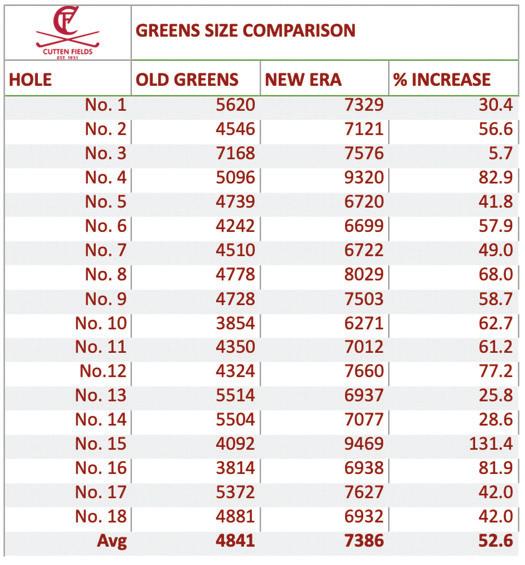
subsequently had more architectural freedom, as we were easily able to adjust on the fly without having to worry about change orders, adding costs, or administrative delays. This unique circumstance led to an exceptional end result.
The team at Cutten Fields are looking forward to focusing on turf health and playability this upcoming season. The membership at Cutten Fields put a lot of trust in Jeff Mingay’s design and the inhouse construction process. It is now time for them to enjoy their newly renovated golf course. ■
JUNE 2024 | ONCourse 17
Golf Course Architect Jeff Mingay looking down the 13th hole at Cutten Fields with superintendent Bill Green and Assistant Superintendent Mark Hughes as they plan their next move.

OM246
Written by and photos provided by Andrew Marsan, Plant Products Inc.
The first draft of this article was set up to be over 3000 words, but only because there is so much valuable information that must be shared when it comes to the topic of OM246. Nothing could be left out! The people must know! Luckily, there’s a limit on how long these articles can be, and that led me here. Scrapped it, regrouped, and got back to the basics.
HERE IS OM246, STRAIGHT TO THE POINT
• Turf managers in New Zealand and the United Kingdom have been utilizing this method of testing for some time. But it wasn’t until a conversation between Dr. Micah Woods of the Asian Turfgrass Center and Chris Tritabaugh, Golf Course Superintendent at Hazeltine National Golf Club, that the term “OM246” was born.
• This is a very different process from traditional organic matter testing. OM246 refers to the total organic material measured at three distinct depths: 0 to 2 cm (2), 2 to 4 cm (4), and 4 to 6 cm (6), whereas standard soil tests for organic matter take a sample at a depth of up to 10 cm.
• See how I did that? Let’s refer to soil organic matter and total organic material as two different things.
• Here’s the difference: The value received for organic matter on a typical soil nutrient test excludes thatch, mat, stems, and roots.
• As a matter of fact, the Soil Science Society of America’s Glossary of Terms defines soil organic matter as “the organic fraction of the soil exclusive of undecayed plant and animal residues.”
• Screened and binned. During the standard process, the sample is first passed through a 2mm sieve, removing the bulk of any living and dead undecomposed plant material, and then a portion of what remains is tested for organic matter
• What we’re used to. This typically results in a value of less than 2% (20g per kg of soil) and is a number that many would be used to seeing on a report and identifying as their organic matter percentage.
• This would be more of a test of humus. Which is certainly still valuable, as it can be utilized to identify the soil’s nutrient and water holding capacity, estimate nitrogen mineralization, and determine the contribution of present organic matter to the soil’s cation exchange capacity.
• Dr. Micah Woods. Defines OM246 as “the measurement by mass loss on ignition of organic material in a soil sample that has not passed through a sieve.”
• Waste not. To get an accurate representation of what is present at the top of the root zone, where the ball reacts, and where it really matters, you must measure everything.
• Up top. There is a significantly higher percentage of organic material closer to the soil surface compared to what exists deeper in the profile, so it makes sense for us to measure and make decisions based on the values at these depths, specifically at 0-2 cm.
SAMPLING PROCESS
• How many? For an 18-hole property, it is typically recommended that at least three greens are tested at the 0-2, 2-4, and 4-6 cm depth, taking five sub-samples from each green, and then an additional three greens are tested at the 0-2 cm depth, resulting in twelve total samples.
18
Tools of the trade.

• Get this ultimate set of tools. You will need a soil profiler or sampler, a clipboard marked at three depths, a knife, labeled bags for the samples, and material to fill the sample holes (plugs or sand).
• How much? We are looking for a minimum of 30 cm3 of sample material, but not exceeding 150 cm3.
• Where to cut? It is important that the 0–2 cm portion of the sample be cut at the soil surface where the grass and soil meet; 0 cm is considered the top of the soil.
• Dry em’ out. Following extraction, the samples must be air dried, which will stop microbial activity and therefore reduce the potential for any decomposition of organic material while shipping.
• Fall is best of all. It is recommended to test in the autumn, as it considers most of the accumulation, growth, removal, dilution, and decomposition from the year prior.
• How often? Annually, preferably at the same time every year.
• Do you have a permit for that? Shipping soil can be tricky if you are not using a local lab, so utilize your certified agronomist or the Asian Turfgrass Center to ensure your ducks are in a row with the entire OM246 process.
AT THE LAB AND TEST RESULTS
• Use it up; use it all up. 100% of the sample is tested at the lab exactly as received, in its entirety, and with the verdure still on.
• Burn, baby, burn. 360°C in a muffle furnace is a conventional burn temperature for soil organic matter testing; however, 440°C is preferred as it results in complete ashing of the sample.
• What’s left? The soil and sand components of the sample will remain the same mass, but the organic material will have burned away to a white ash, resulting in the mass lost on ignition.
• On your physical analysis report. This will be reported as a percentage—the mass of organic material per mass of soil.

THINK
ONCE. THINK ICE ARMOUR.
You have enough things to worry about each spring – what if your greens weren’t one of them?
A great start to spring begins with Ice Armour this fall.
Combining our exclusive Green Jacket covers and Futerra 7020 matting, the Ice Armour System insulates your greens and blocks moisture while letting air flow in and out. This allows your greens to thrive through a wide range of weather patterns all winter long and come out ready to open on the other side.
Ease your worries this off-season and put a smile on your team’s face next spring with the Ice Armour System from BrettYoung.


JUNE 2024 | ONCourse 19 1-800-665-5015 | brettyoung.ca
Sample report –The results of your OM246 testing will look something like this.

• For example. A report showing a 0–2 cm value of 6.24% means there is 62.4 g of organic material per 1 kg of sample.
OK, NOW WHAT?
• Getting your feet wet. It is important to be patient during year one of the process because, although you now have this data, it can be difficult to quantify the results until your next sample results arrive.
• Through ATC. In the reports Dr. Woods provides, he will show
how your total organic material percentages stack up against those from greens of a similar turf composition.
• BUT! Fight the urge to make comparisons; it is not apples to apples, and decisions should not be made solely based on the results of others.
• G2G. It is also valuable to look at how the total organic material percentage changes from green to green on your property and the effects of different microclimates and growing conditions.
• Where it really pays off. Is observing how the total organic
20
Air drying the samples following extraction is necessary to stop microbial activity but it also reduces shipping costs. Score!
material changes over time—is it going up, going down, or staying the same?
• And then? One can properly assess if the maintenance work that has been done to influence the organic material percentage has been adequate, not enough, or too much.
• You should know. How much topdressing sand and nitrogen has been applied, how the grass was grown by collecting clipping volume, and how much surface disruption (aeration, verticutting, etc.) occurred between sampling dates and in what capacity.
• Don’t forget to measure the surface performance! OM246 is just one piece of the puzzle; ensure you are collecting performance data such as green speeds, measures of smoothness and trueness, firmness, and VWC.
another golf course nearby or surfaces of the same composition.
• We are not all the same. Great putting surfaces have been observed at 5%, and at 15% organic material - there is no right or wrong number; the key is finding what’s best for your site.
“What is the ultimate goal with OM246 testing? Maximizing putting green performance and achieving the desired conditions for your site while minimizing disruptive practices.”
• Easy there. Remember, the more grass you grow up top, the more you grow down below; keep your growth rate in check, and the organic material accumulation will be less.
• Where you at? Over time, one will be able to really dial in the conditions they desire, first by identifying what those conditions are and then adjusting the work appropriately to achieve the best surfaces possible for the greatest number of days in the season.
BITS AND BOBS
• OM gets a bad rap. But it has been observed that the betterperforming, heathier greens on a property contained the highest levels of OM at the 0-2 cm depth, and the greens that tended to struggle and were considered the weaker, higher-maintenance surfaces had the lowest levels of OM.
• So, what are you saying? This shows us that the poorest turf growth is occurring in soils with the lowest organic material, so maybe we need to think differently.
• How low can you go? We’ve always thought that the lower we can get this number, the better, and we base our maintenance practices around this idea.
• Instead. Try looking at it like this: how much organic material is tolerable while still producing the desired playing conditions, not how little.
• For the record. In no way am I suggesting jacking these numbers up to make the greens better; instead, utilize this testing to find your site-specific optimum level of OM and manage the surfaces in a way that can keep you there.
• Target practice. It is important to remember that there is no “target” or ideal total organic material percentage; what is sufficient at one property will be completely different from
There are loads of other goodies we could dig into, but for the purpose of this article, I think you get the point. Whether you are utilizing your local agronomist, Dr. Micah Woods of the Asian Turfgrass Center, the STRI, NZSTI, or USGA, give it a shot. I haven’t heard of a case where one did not find immense value in this type of testing and all that comes with it. Let’s end with this: what is the ultimate goal with OM246 testing? Maximizing putting green performance and achieving the desired conditions for your site while minimizing disruptive practices that may not be necessary in the capacity or frequency that they are currently being performed. That would be this working very well, I’d say. ■
WaterIQ Technologies™ ALGAE DEFENSE
WaterIQ Technologies ultrasonic solutions remove algae and biofilm in ponds and lakes safely and efficiently. Our products help ensure that waters are safe, algae-free, aesthetically pleasing, and welcoming to wildlife.

| Tel: 905-269-6518 www.aquatic-aeration-solutions.com
JUNE 2024 | ONCourse 21
AQUATIC AERATION SOLUTIONS aquatic.aeration.solutions@gmail.com

Training Culture?
QUESTIONS FOR TRAINING-PROGRAM PLANNING & EXECUTION
Written by Mark Wiebe, Assistant Superintendent, Oakdale G&CC.
Training, training, training. It’s a word we talk about, plan for, and execute every season on our golf courses. Training-programs may be the most important factor in producing both tangible and, when reaching our full potential as leaders as well as a team, intangible results.
Besides helping ensure our safety and improving the physical features of our golf courses, what else can a comprehensive, creative, and consistently executed trainingprogram do for us? And, what else could be required for our training-programs to be effectively executed? Of course, there’s no one-size-fits-all answer. But, after breaking our future plans and past executions down into their contingent parts and after asking ourselves the right questions, we can make the best decision on how to move forward.
Our golf courses, the individuals who maintain them, and we as leaders can then reap all the benefits.
EXPECTATION VS. CARE
Most, if not all the work that goes into maintaining a golf course is very detailed. Our training-programs often reflect this detail-oriented nature of the work. One of the greatest challenges and glaring contradictions of it all is this: the majority of the individuals who we hire, train, and rely upon to carry out the work won’t always care as much, or be as highly motivated as we are. A strong training-program with clear and concise process standards and a system of accountability can help remedy this expectation versus care imbalance. Other than reaching the balance between thoroughness, ease of use and adaptability, what else makes a training-program strong for our seasonal staff?
FREEDOM VS. CONTROL
If being free, that is, using our own directing mind and intuition, has a connection with being strong, we’re forced to question its importance in our trainingprograms. Although contradicting the expectations versus care imbalance we can often encounter, people still seem to inevitably slump and perform poorly when the workplace and training is being influenced too heavily by the opposite spectrum of freedom: control. Therefore, looking through this lens of control versus freedom we can over time, and as trust in our program increases, ask ourselves: how can we shift further into the spectrum of freedom? What does freedom within a training-program mean to us? Having this balance of freedom versus control can have several benefits that may contribute to a positive and productive workplace. Again, there’s no perfect answer. We’ll never have
22
“arrived” at the perfect place. That’s for us as leaders to always question, work on, and get ever closer to. This much is clear. The many benefits, all of which can be seen through both an individual or collective viewpoint, are well worth the effort.
INDIVIDUAL & COLLECTIVE PERFORMANCE
Like plotting out the stops on a trip to somewhere you’ve never been or finding out where your classes were before the first day of school, many of us like to know what we’re getting into. When we know what we’re getting into, we’re more at ease and confident. When we’re more at ease and confident, we’re more likely to perform at a higher level. The trickle-down effect of getting this right from the start can be a game changer. When new members of our team see the confidence and trust gained from our own commitment to their training and development from the get-go, there can be a collective rise in morale and overall positivity. Feelings, thoughts, actions – a sequence that’s important to consider from the start and all the way through.
ENGAGEMENT & INCLUSIVENESS
Our training-programs offer the first and ongoing opportunity to encourage engagement and inclusiveness. Feeling like you’re a key member of a team and something bigger than yourself usually inspires good thoughts.
Good thoughts inspire good actions. Adding opportunities for feedback from our trainees as well as those who are delivering the training is one example of how we can build engagement and inclusiveness into our training-program. When one person on our team sees this openness, and how they can affect the operation, it can create a collective realization and the motivation to achieve excellence.
ACCOUNTABILITY
Another more practical, but at the same time less obvious way to create accountability is within our training-programs and a “training culture.” Evaluation of completed work after training is a traditional way to hold our people accountable. Meeting the specific steps within a standard operating procedure document used for training is another, and arguably more accurate way to do this. The same collective realization and motivator to reach uniform standards will also encourage people to hold each other accountable and, more critically, to hold themselves accountable.
LEADERSHIP
When those on our team hold themselves and each other accountable, each of them becomes a leader. From a more individual viewpoint, developing the trainers on our team can only enhance their leadership skills and therefore, their ability to consistently execute our training-programs. When you feel, think, and act like you
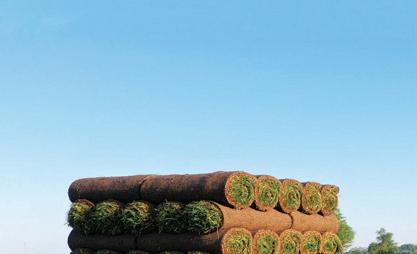





matter, like you’re a part of something bigger than yourself, you’re more apt to consistently perform at a higher level, to hold yourself and those around you accountable, and, most importantly, to be a leader. Keeping the big picture in mind and at the center of our training culture can help keep individual and collective viewpoints aligned. The big picture may change from place to place, different circumstances and styles of management and leadership, but some things never change. Taking pride in maintaining a beautiful golf course for our members, guests, or customers and, most importantly, being a good teammate will always be cornerstones of success. There may be no one-size-fits-all answers, but we can always ask ourselves how a training culture could help our golf course, our teams, and ourselves as leaders in reaching our full potential.
Follow the QR code which links to an example of a process checklist, or standard operating procedure document with sections for feedback from trainers and supervisors. ■






JUNE 2024 | ONCourse 23
Seeding is Believing Simple Dimple Seeder Bannerman B-SDS-4-H 1.Accurately dispenses bent grass & blue grass seed 2.Easy to calibrate – variable seeding rates 3.Break up ice on Greens 4.Tow with any turf vehicle Call Bannerman today: 1-800-325-4871

Investing in Your Team
Written by Kevin Collier, Superintendent, RiverBend GC.
When we think “investing,” we relate back to pensions, RRSPs, home ownership, and finances. All of these things can provide a form of satisfaction and comfort in our everyday lives. The same can be said of investing in our teams. Our dedicated teams provide a product and experience to our members and customers and not one person can do it on their own. We rely heavily on our teams to complete important goals throughout their day and the demands can be extremely high, especially when the heat of the summer arrives.
Having an engaged team is critical to our success and we have to find ways to connect to each team member. The challenge is –how? Our teams are so diverse in respect to age, experiences, and career paths. This can be testing as each team member requires different levels of support. We generally lump each demographic into the perceptions of their generation, and we have to ask ourselves – is this fair? In my personal experience, taking the time to familiarize yourself with the wants and needs of each team member has provided the best opportunity to drive engagement along with the development of the team. Each team member is motivated differently and requires different forms of recognition to reach a level of achievement. We have to maintain awareness of the various generations, with an open mind, as they do provide data and tendencies which are great tools that provide us with the opportunity to adjust and communicate. I personally enjoy when a team member differs completely from what the generational period predicts, as it truly makes us think differently as leaders to ensure the success of our team member and operation.
While some forms of investment in the team may involve a financial contribution which may require approval from ownership, there are many other ways in which we can significantly invest in our teams with little to no cost, just time and energy.
FREQUENT CHECK-INS
Take the time as frequently as you can to connect with your team individually and in groups. Get to know them; initiate friendly conversations to find out what their interests are, where they go to school, their career experience, and other topics to promote engagement.
ANNUAL PERFORMANCE REVIEWS
Completing a formal review for all of your team members provides a great opportunity to sit down and have a two-way conversation about the year. Parts of these reviews may seem redundant to some, especially if your frequent in-season communications are effective. But I personally find that there are still great benefits in taking this time. The two most significant questions our team discusses are:
1.How have you enjoyed your experience this past season?
2.How can we improve your experience next year?
Let’s be honest. Sometimes it isn’t easy to discuss the negative feedback, however in my experience, these conversations will make it better for your operations moving forward. We have seen improvements or changes in scheduling, uniforms, job rotation, training styles, and operational processes. Our team has had the opportunity to improve each year by empowering our team members to let us know how their experience was. You can only imagine how they feel when they return the following seasons to find that their voices were heard!
24
Photo provided by the OGSA.
Investing your time with frequent check-ins and recognition promotes engagement. Take the time to initiate conversation and get to know your team. Photo: Dean Baker, Burlington G&CC and his team during OGSA superintendent recognition presentation.
PROVIDING OPPORTUNITY FOR HIGH PERFORMERS
A challenge we face in this industry continues to be finding skilled and dedicated team members for our operations. Once we have found those exceptionally hard workers, a new challenge is having team members who want more responsibility and more opportunities.
What can we provide? One suggestion I can make based on what our team does is encouraging them to obtain a landscape exterminators license as it is a big tool for our operations; this can help support that desire for accomplishment and growth. Upon completion, our team members will be reimbursed for all costs associated with the process along with an adjustment to their wage as they would enter a new wage grid due to their technical qualifications.
WORK, LIFE, AND BALANCE
Scheduling for operations continues to evolve over time and creating a program which allows for our entire team to do the things that they want at work and, most importantly (for most), the things they want away from work too, can be tough – especially in the middle of the summer when it’s far more challenging to provide flexibility. However, when the effort is made to provide the team with their desired time off, you will find yourself with a positive crew, always ready to go at 5am each and every day. When the team member is engaged to be at work, their productivity and attitude promote a great culture for success.
“Analyzing golf course membership surveys and feedback is a great unit of measure for the success of your investments in the team.”
It’s rewarding in itself to watch the team support those working toward their license, as well as the recognition and respect when they pass the exam. Those who have gone through this program have been high performers and with each accomplishment their confidence grows larger, which has a positive influence on the rest of the team’s engagement and growth.


Analyzing golf course membership surveys and feedback is a great unit of measure for the success of your investments in the team. When everyone behind the scenes is positive, enthusiastic, and empowered, work ethic flourishes, and we can anticipate a job well done as a result. A happy membership and positive feedback is a true reflection of the strength of your team.
Investing in your teams can be one of the best uses of your time and I still remember the first time I heard the comment: “10% of your job will be growing grass, 90% is the rest.” As I continue to evolve and develop through educational and networking opportunities to learn from colleagues, investing in your team can be the best guaranteed investment you can make! ■







Aqueduct Flex contains an exclusive dual-action formula speci cally designed to give turf care professionals superior performance with exible options for dealing with stressful conditions, including water repellency and localized dry spot. To learn more about Aqueduct Flex visit: Can.Aquatrols.com/Flex



SPOT
A FAST ACTING DUAL-ACTION GRANULAR THAT TREATS AND PREVENTS LOCALIZED DRY
Jonathan Albert Territory Manager jalbert@aquatrols.com (438) 507-9088


When all your data is in one place, you can be any place.

Track your tasks better with John Deere Operations Center™ PRO Golf
Manage your course like never before with the new comprehensive golf course management solution from John Deere. With John Deere PRO Golf, you can monitor crew hours, machine health, equipment location, and more—all on one customizable platform accessible from any connected device.
Contact your local John Deere dealer to schedule a demo.



LOOKING BACK
Fifty Years Ago, Today




In 1974, the O.G.S.A. was celebrating its 50th Anniversary. The Board of Directors were Bob Heron (president), Paul Dermott (vice), Al Beeney (secretary), Whitey Jones, Bob Hall, John Stoughton, Cameron Cairncross, Carl Bennett, Helmut Kopp, Paul Scenna, Jim Wyllie (past president), and Ross Haines (newsletter editor).
NEW MEMBERS
Members joining the O.G.S.A. that year were Ken Wright, Northwood Golf and Country Club, Wendell Dyment, Big Cedar Golf and Country Club, Dave Dick, Sleepy Hollow Golf Club and Gerry Laferriere, Garion Golf Club, Sudbury. Annual dues were increased from $20.00 to $30.00 per year.
ON THE MOVE
Sam DiPinto, of the Lido Golf Centre, accepted the superintendent position at the Beverley Golf Club. Steve Miller moved from being assistant at the Toronto Board of Trade Country Club to Dundas Valley Golf Club as superintendent. Jack Harris retired from the Hamilton Golf Club to build his own golf course called Knollwood Golf Course. Stuart Mills moved from London Highland Golf Club to Hamilton Golf Club. Graham Shouldice took over as superintendent at the Highland Golf Club.
IN MEMORIAM
Taylor Barnes passed away in March and Norm MacDonald, a former Superintendent at York Downs Golf Club, also passed away.
EVENTS
The Fourth Annual Turfgrass Symposium of the O.G.S.A. was held on January 3rd at the Lambton Golf and Country Club with Jim Wyllie as host. Seventy-five people attended and Keith Nesbit was the Session Chairman for the day.
Stuart Mills helped make ice for the Canadian Curling Championships in London and Helmut Kopp won a gold medal at the Hotdog Championships at Blue Mountain.
The February monthly meeting was held at Uplands Golf Club in Thornhill hosted by Helmut Kopp. It was a combined skiing, business and lecture meeting.
The G.C.S.A.A. Conference and Show was held in Anaheim California and the R.C.G.A. Turfgrass Conference and Show was held in Winnipeg, Manitoba.
Superintendents met weekly at the Centennial Arena in Etobicoke for hockey. Blake McMaster, Gormley Green, Bruce Lewis, Georgetown, Whitey Jones, Aurora, Helmut Kopp, Uplands, Carl Bennett, Oakville, Paul Dermott, Islington and Bob Heron, Markland Wood all participated.
Minimum wage was $1.65 per hour for a student under 18. Working under 28 hours was $1.90 per hour for a learner during his first month and $2.00 per hour for general employees.
TOURNAMENTS
On August 9th, the Pro-Superintendent Golf Tournament was held at the Brampton Golf Club with Ross Haines as host.
The O.G.S.A. held its 50th Anniversary Golf Tournament at Lambton Golf and Country Club with Jim Wyllie as host. ■

Barry Endicott Retired Golf Course Superintendent Brampton, Ontario Tel: 905-846-1440
barry.endicott@gmail.com
JUNE 2024 | ONCourse 27
1974 Board of Directors.
Jim Wyllie, Lambton G&CC, host superintendent of the Fourth Annual Turfgrass Symposium of the OGSA.
OGSA Celebrates its 50th Anniversary.
Jim Wyllie handing over the gavel to incoming OGSA President Bob Heron.
LOOKING BACK





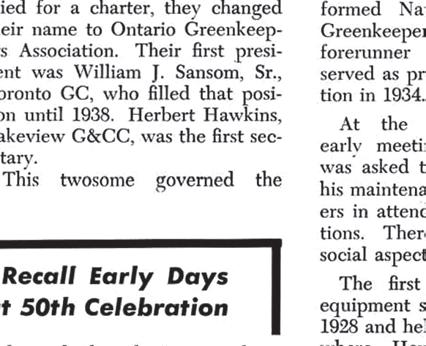










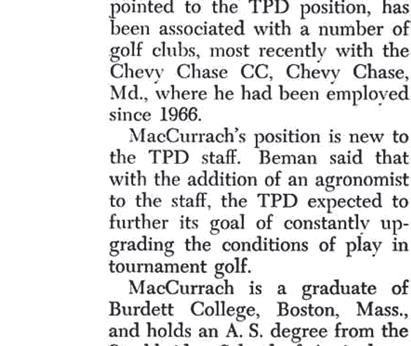









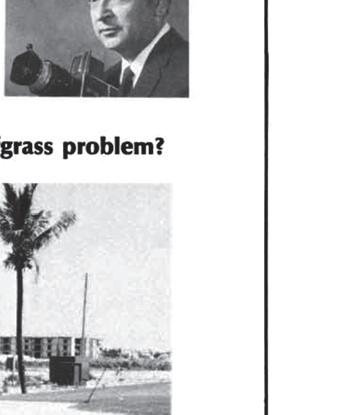





| ONCourse
SPRING 2024
Father of the Bride
Written by Doug Breen, Superintendent, Golf North Properties.
Well, yesterday was a big one. It was a ‘top five days of my life’ kinda day. My daughter got married to a fine young man, and I made the shockingly long walk down the aisle with her and my wife Krista. It wasn’t a physically long walk - but in a metaphysical sense, it was twenty-five years’ worth of hoping, laughing, worrying, teaching, admonishing, coaching and praying for a day just like that one. It seems like just last week she was a toddler, riding around on the Gator with me, fixing ball marks while I changed holes on the weekend - now she’s all grown up.
She started the day as a Breen, but by midafternoon she was known as Aniela Ferraro. That’s a seriously good moniker - it sounds like the name of a 1960’s Italian movie star. Aniela Ferraro would take a yacht from Monaco to Tuscany, and then drive a Ferrari to Rome for the weekend. Aniela Breen would spend that weekend building a fence.
We held the wedding in a renovated barn at the Exeter Golf Club. The irony is not lost on me, that I spent the first 19 years of my life trying to get out of a barn – and then paid a lot of money so that my daughter could get married in a barnyard and have her reception in a hay mow. There’s a chandelier hanging from the hayfork track. I had tried to avoid having the wedding at a GolfNorth facility, as I didn’t want to put that much pressure on the staff. It’s tough enough to relax on your own golf course, when your guests are just playing a round or eating a meal in the restaurant, but a wedding comes with an extra level of anxiety for everyone involved.
Adding to the normal level of stress, we had multiple contractors still doing work on the venue while the rehearsal was happening. They had assured me right up until a few days before, that everything would be ready for the wedding. I should have known better; because they had also guaranteed that construction would be done before we opened - and April 1st, and Easter Brunch,

and May 1st… They didn’t meet any of those deadlines, and they weren’t finished by the wedding deadline either. On the bright side, the completed parts of the project were great, and there were very few of us who knew about the incomplete bits. Nevertheless, I was certainly feeling like Steve Martin in “Father of the Bride”.
Fortunately, our daughter Aniela is legendary for her toughness. When she was four years old, she demanded that I remove the training wheels from her bike, because her brother didn’t have any. After spending a few hours turning only left, she finally figured it out. The next day, we rode 40 kms on a rail trail. She was crying at the end, but I think it was mostly from the swarms of deer flies that were eating her alive.
She tried Box Lacrosse because some of her friends and hockey coaches thought she would be good at it. She played for three seasons and won three provincial AAA championships. Her Rugby career in high school led to three OFSSA medals and a little bit of cauliflower ear. She rowed for one season, and her dryland training had her ranked in the top five in the province. Before they put a boat in the water, she was offered a spot at Queens University – but she declined because “I don’t like boats.” I tried counting her Provincial and League
championships in hockey but can’t figure it out – there were a lot. She was captain of her high school hockey team as a senior, and they won another OFSSA medal. But these were just dalliances. The only sport she ever really loved was horses - she was jumping horses cross country, and perfecting flying lead changes while other kids were in walk trot classes.
So it wasn’t surprising, that in the end, it was her calming me down, and she handled each imperfection in the same stoic manner as she had done in all of those sports. Some say that competition builds character, but I side with those who say it reveals character – and she had enough for both of us.
Almost two years ago, I was walking through the Halifax airport, frustrated by a particularly bad week of work, and honestly feeling pretty sorry for myself. My phone rang, and it was the young man who is now my son-in-law. My first thought was that something was wrong. Nobody ever calls to tell me to tell me how great things are going – those calls go to Krista. I get the car accident, flat tire, no hot water calls. But he was calling to tell me that he was going to propose to Aniela and wanted my blessing. It was an old-fashioned traditional thing, that I didn’t think people did anymore. Twenty minutes later, I hung up knowing that Aniela and their future family were in good hands, and at that moment I didn’t care about work, or budgets, or deadlines, or flight delays, or the emails in my inbox. In the face of the thousands of mistakes that I had made as a parent – in the end, she had grown up just fine in spite of me. She had found a hard working, honest, and thoughtful young man who saw all the wonderful things in her that I did.
So yesterday was a big day - but it wasn’t about me, or contractors, or venues, or dresses or flowers, or any of those things. Two young people were as happy as anyone I’ve ever seen, and two families have been forever united. I’ve always been proud of Aniela, but never more proud than yesterday. ■
30
TURF OR CONSEQUENCES




SOD & INSTALLATION SERVICES FOR GOLF COURSES
Golf is in our blood here at Greenhorizons. Producing, installing & servicing the highest quality sod for golf courses for over 40 years! We’ve worked for decades to produce and install the highest quality sod for golf. Growing premium quality turfgrass since 1975 has provided us with the knowledge to produce numerous specialty sod blends for all golf course applications. From greens, to fairways, to rough; Greenhorizons grows it all:
• USGA Greens Bentgrass • Tees & Fairways Bentgrass • Pure Fine Fescue



Hamilton (905) 389-1315 • Cambridge (519) 653-7494 GreenhorizonsSod.com/golfcourses
r
F Success!
Y
Ultimate SOD PARTNER • Dwarf Low-Mow Bluegrass • Premium Bluegrass • Spectrum Sod – Our Smart Sod Solution





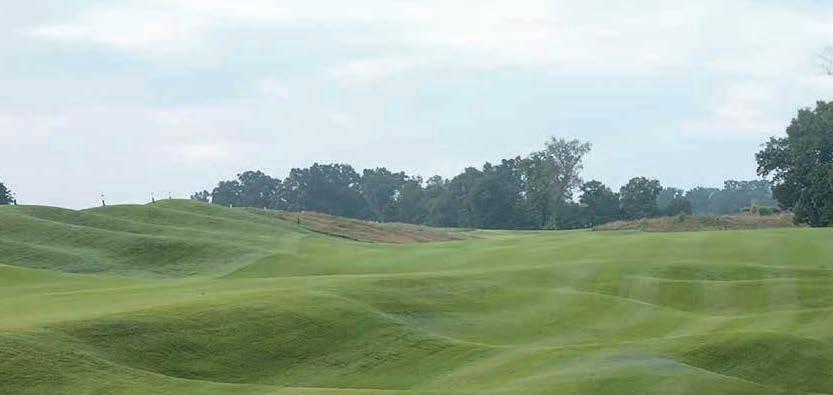













Golf’s Most Versatile Machine 1-800-561-TURF (8873) | inquiries@t urfcare.ca | turfcare.ca Get in touch with your local Turf Care Sales Representative to learn more or book a free demo. @TurfCareProdCA @Gr8estShowOnTRF
OF PRE-OWNED EQUIPMENT Ask us about our flexible financing solutions | Turf Care offers a range of leasing solutions to help your course acquire the equipment and services you need now, with an affordable monthly payment. 30+ quick-connect attachments for year-round productivity Patented design and controls make it stable on steep slopes and challenging terrain Turf-friendly light footprint Ü Ü Ü Great value on a large inventory of AS IS and Serviced Equipment ALL MAJOR BRANDS We have units in-stock and available for immediate delivery!
Your Largest Supplier



































































 By Courtney White, Executive Manager OGSA. manager@ogsa.ca
By Courtney White, Executive Manager OGSA. manager@ogsa.ca


























 Written by Lisa Marie Guilfoyle, Assistant Superintendent, Oakville Golf Club. Photos provided by Amanda Frend.
Written by Lisa Marie Guilfoyle, Assistant Superintendent, Oakville Golf Club. Photos provided by Amanda Frend.





























































































































